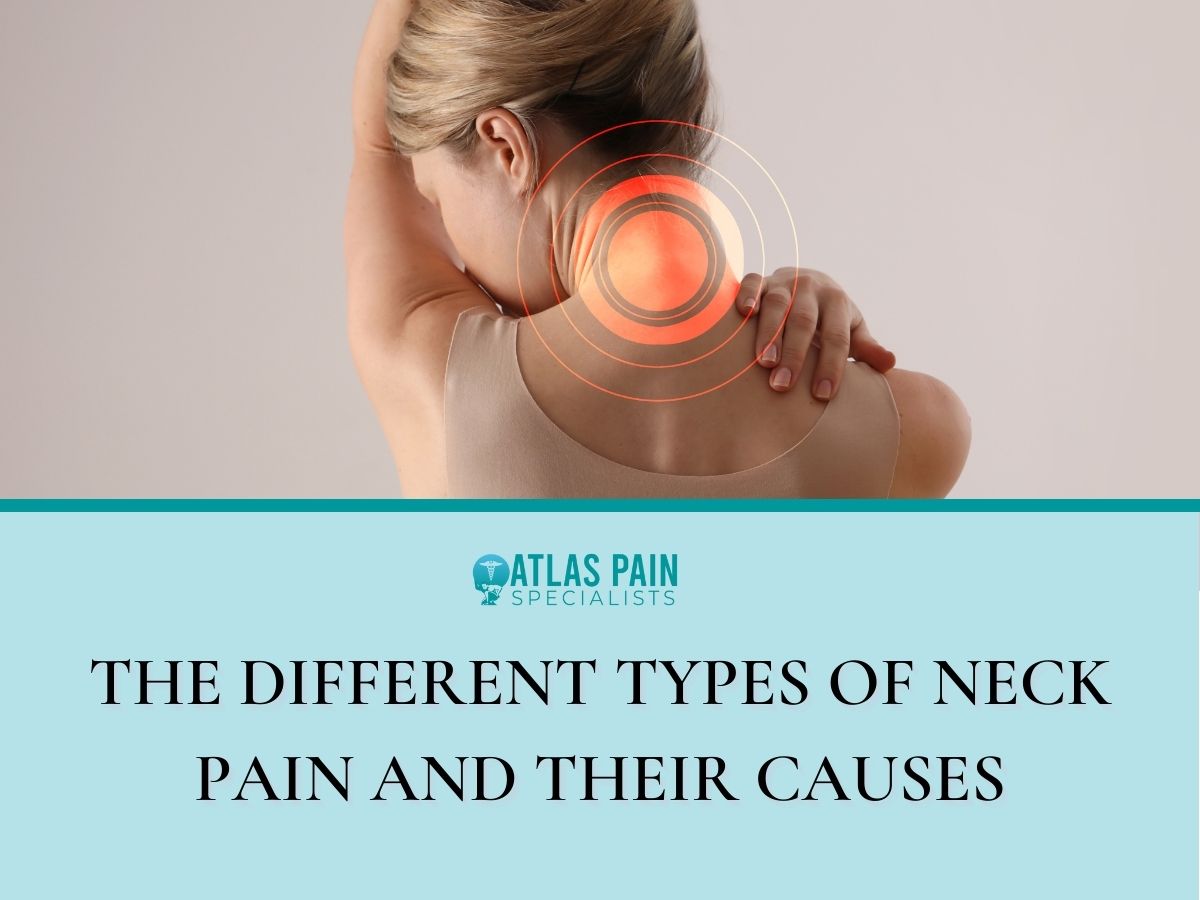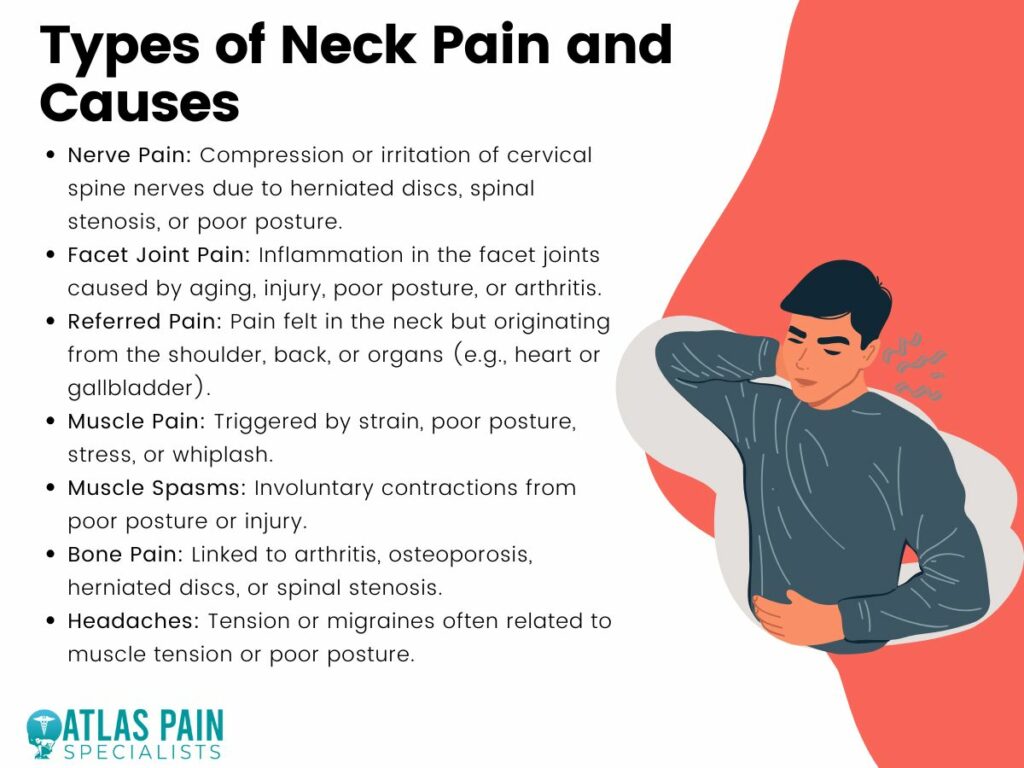

The Different Types of Neck Pain and Their Causes
Neck pain affects 75% of the population worldwide and is one of the top pain conditions in the United States. Despite its commonality, neck pain is not the same for everyone. There are different types of neck pain, such as facet joint, bone, muscle, and others, each with potential reasons. The first step to eliminating pain is to determine the type of pain you are experiencing and its common causes.
In this article, you'll learn more about the different types of neck pain, their causes, and tips on how to address them.
Table of Contents
Nerve Pain

Neck pain due to nerve pain is quite challenging to define. Nerve pain in the neck is often caused by compression or irritation of the nerves in the cervical spine, which can lead to pain, tingling, numbness, or weakness in the neck, shoulder, arm, or hand.
To explain it further, each vertebra serves as the exit point for one or more nerves branching off the spinal cord. Pain can be described as intense or dull, fleeting or chronic, and accompanied by burning sensations or a pins-and-needles sensation that might be caused by inflammation or structural damage close to these exit points.
Additionally, nerve pain in the neck often occurs due to cervical radiculopathy; a nerve root in the cervical spine (neck) becomes compressed or irritated. Nerve pain in the neck can be caused by several factors, including:
- Cervical herniated disc: When a disc in the cervical spine becomes herniated, the inner material can compress a nerve root and cause pain in the neck and arm.
- Spinal stenosis: A spinal canal narrowing can compress the nerves in the cervical spine, leading to pain.
- Cervical radiculopathy: This condition is caused by compression or irritation of a nerve root in the cervical spine, resulting in pain and other symptoms that may radiate down the arm.
- Pinched nerve: Pressure on a nerve in the neck can cause pain, numbness, tingling, or weakness in the neck, shoulder, arm, or hand.
- Whiplash injury: A sudden impact that causes the neck to jerk forward and backward can cause nerve damage and pain.
- Arthritis: Osteoarthritis or rheumatoid arthritis can cause degenerative changes in the cervical spine that compress nerves and cause pain.
- Poor posture: Slouching or sitting with your neck in an awkward position for extended periods can cause nerve pain in the neck.
It's important to consult a healthcare provider to determine your nerve pain's underlying cause and develop an appropriate treatment plan. Treatment may involve a combination of medication, physical therapy, and other therapies to provide relief and improve the overall quality of life.
Facet Joint Pain

The facet joints are located in the back of the neck and help to provide stability and allow for movement in the cervical spine. When these joints become irritated or inflamed, it can result in pain and stiffness in the neck.
The pain from facet joint dysfunction is typically felt on one side of the neck and may also be accompanied by headaches, shoulder pain, and limited range of motion in the neck.
Facet joint pain can be caused by various factors, including:
- Degenerative changes: As we age, the cartilage that covers the facet joints can break down, resulting in bone-on-bone contact that can cause pain.
- Trauma or injury: A sudden injury, such as a car accident or a fall, can damage the facet joints and lead to pain.
- Poor posture: Poor posture, particularly over an extended period, can place added pressure on the facet joints and contribute to pain.
- Repetitive strain: Activities that involve repetitive motions, such as bending or twisting, can cause wear and tear on the facet joints and lead to pain.
- Arthritis: Arthritis, particularly osteoarthritis, can cause degenerative changes in the facet joints and lead to pain.
- Obesity: Excess weight can place additional stress on the facet joints and contribute to pain.
- Genetics: Certain genetic factors may contribute to the development of facet joint pain.
If you suspect that your neck pain is caused by facet joint dysfunction, it is crucial to see a healthcare professional for an accurate diagnosis and appropriate treatment. Treatment options for facet joint pain may include physical therapy, chiropractic care, medication, and in severe cases, surgery.
Referred Pain

Referred pain in the neck is felt in the neck but originates from another part of the body. Referred pain occurs when the nerves that supply different body areas converge on the same spinal cord levels. This can result in pain being felt in an area that is distant from the actual source of the problem.
In the case of referred neck pain, the pain may originate from various sources such as the shoulder, upper back, jaw, or even internal organs like the heart or lungs. The pain may be a dull ache, sharp or shooting pain, or a burning sensation, accompanied by other symptoms such as numbness, tingling, or weakness.
Here are some common causes of referred pain that can lead to neck pain:
- Heart attack: During a heart attack, pain signals can be referred to the neck, arms, and shoulders.
- Gallbladder disease: Gallbladder disease can cause referred pain in the upper right quadrant of the abdomen, which can be felt in the neck and shoulder.
- Pancreatitis: Inflammation of the pancreas can cause referred pain in the upper back and neck.
- Cervical radiculopathy: Cervical radiculopathy is a condition where nerve roots in the neck become compressed or irritated, causing pain that can be felt in the neck, shoulder, and arm.
- Shoulder injuries: Injuries to the shoulder, such as rotator cuff injuries or shoulder impingement syndrome, can cause referred pain in the neck.
- Temporomandibular joint (TMJ): A disorder is when the joint that connects the jawbone to the skull becomes inflamed, causing pain that can be referred to the neck and shoulders.
- Fibromyalgia: Fibromyalgia is a chronic pain disorder that can cause widespread pain in the neck and shoulders.
Referred neck pain can be challenging to diagnose because the source of the pain may not be obvious. A thorough medical evaluation is necessary to identify the underlying cause of the pain and determine the appropriate treatment.
Treatment options for referred neck pain depend on the underlying cause and may include medication, physical therapy, chiropractic care, or in severe cases, surgery.
Muscle Pain

Muscle pain, also known as myalgia, is a type of pain that originates in the muscles themselves, which can lead to neck pain. Several muscles in the neck region work together to support the head and enable neck movement.
These muscles become tense, inflamed, or strained; they can cause neck pain. Common reasons for muscle pain in the neck include:
- Muscle strain: Overuse, awkward sleeping positions, or lifting heavy objects can cause muscle strain in the neck.
- Poor posture: Sitting or standing with poor posture for extended periods can lead to muscle imbalances and tension in the neck.
- Stress: Emotional stress can cause muscle tension in the neck.
- Whiplash: A sudden impact or force, such as in a car accident or sports injury, can cause neck muscles to stretch or tear, leading to pain.
- Repetitive motion: Performing repetitive tasks or maintaining the same posture for long periods can cause muscle fatigue and neck pain.
Medication, physical therapy, or other therapies may be used as part of the treatment plan to reduce this type of neck pain and increase mobility.
Muscle Spasm
Unlike muscle pain which is a type of discomfort that originates in the muscles themselves, muscle spasms are sudden, involuntary contractions of a muscle or group of muscles.
Muscle spasms can cause neck pain by causing the muscles in the neck to contract involuntarily, leading to pain, stiffness, and a limited range of motion. It can occur due to various factors, such as poor posture, muscle strain, overuse, or injury.
Here are some ways muscle spasms can cause neck pain:
- Muscle tension: Muscle spasms can cause the muscles in the neck to become tense and tight, leading to pain and discomfort.
- Limited range of motion: Muscle spasms can limit the range of motion in the neck, making it difficult to move the neck and causing pain when trying to do so.
- Trigger points: Muscle spasms can cause trigger points, which are areas of tightness and tenderness within the muscle tissue. Trigger points can cause pain radiating to other body areas, including the neck.
- Nerve compression: In some cases, muscle spasms can compress nerves in the neck, leading to pain, numbness, and tingling in the neck and arms.
- Poor posture: Poor posture, such as using your smartphone excessively and in an awkward position, can cause muscle spasms in the neck muscles, leading to pain and discomfort.
If you are experiencing neck pain caused by muscle spasms, there are several ways to manage the pain and prevent future episodes. These may include heat or cold therapy, massage therapy, stretching exercises, over-the-counter pain relievers, and physical therapy.
It's essential to consult with a healthcare provider if your neck pain persists or is severe, as it may be a sign of an underlying condition that requires medical treatment.
Bone Pain

Most neck discomfort is caused by diseases and injuries to the cervical spine's soft tissue structures. However, the actual bones themselves may also be a reason for neck pain.
Although neck pain in the cervical vertebrae is much less joint than neck pain in the soft tissues, it still has to be treated immediately because it could indicate a more serious health concern.
It is especially true if the pain is mainly related to an underlying condition affecting the bones or joints of the neck. Moreover, bone pain can be a symptom of bone deterioration or a fracture, which could endanger your spinal cord by destabilizing the cervical spinal column.
Here are some common causes of bone pain that can lead to neck pain:
- Arthritis: Arthritis is a condition that causes inflammation and damage to the joints and can affect the joints in the neck. Arthritis in the neck can cause pain, stiffness, and a limited range of motion.
- Osteoporosis: Osteoporosis is a condition that causes bones to become weak and brittle, increasing the risk of fractures. If the vertebrae in the neck become weakened due to osteoporosis, it can cause pain and limited mobility.
- Herniated disc: A herniated disc occurs when the soft tissue between the vertebrae in the neck becomes damaged or ruptured, causing pain and nerve compression. This can lead to pain, numbness, and weakness in the neck, shoulders, and arms.
- Spinal stenosis: Spinal stenosis is when the spinal canal narrows, putting pressure on the spinal cord and nerves. This can cause pain, numbness, and weakness in the neck and arms.
If you are experiencing neck pain related to bone pain, it's essential to consult with a healthcare provider to determine the underlying cause and develop an appropriate treatment plan. Treatment may include pain management, physical therapy, medication, or surgery, depending on the cause and severity of the condition.
Headache
Headaches can sometimes cause neck pain, particularly tension headaches, and migraines. Tension headaches are the most common type of headache, and they often cause neck pain and muscle tension in the neck and shoulders.
Migraines can also cause neck pain and other symptoms such as nausea, sensitivity to light, and visual disturbances. To explain it further, here are some ways in which headaches can cause neck pain:
- Tension headaches: Tension headaches are the most common type of headache caused by muscle tension and stress. This tension can cause pain in the neck, shoulders, and scalp.
- Migraine headaches: Migraine headaches can cause neck pain in some people, particularly during the early stages of the headache. The pain is typically located on one side of the head but can spread to the neck and shoulders.
- Cervicogenic headaches: Cervicogenic headaches are headaches that are caused by problems in the neck, such as cervical spine disorders, muscle tension, or nerve compression. The pain is typically felt on one side of the head and neck.
- Cluster headaches: Cluster headaches are severe, recurring headaches often described as a burning or piercing pain behind one eye. These headaches can also cause neck pain.
- Posture-related headaches: Poor postures and hunching over a computer or phone can cause strain on the neck and lead to headaches that cause neck pain.
One simple but effective tip to remedy a headache is to try to relax and reduce stress. Stress can be a significant trigger, so finding ways to relax and de-stress can help manage your pain.
It may include deep breathing, meditation, or gentle stretching. Another is to pay attention to your diet and avoid foods or drinks that may trigger your head pain.
When treating a severe headache, the first step is accurately diagnosing the pain's cause.Common triggers include caffeine, alcohol, and certain types of food additives. Staying hydrated and getting enough sleep can also help manage head pain.
This may include imaging tests such as CT scans or MRIs, physical exams, and even blood tests to rule out any underlying medical conditions.

Key Takeaway
Neck pain can be a discomforting experience that can limit your range of motion and overall quality of life; this type of pain doesn’t go away quickly. If the pain in your neck becomes chronic, you may need help to address emotional, social, and environmental factors that may be contributing to your pain.
While the cause of your neck pain may be an isolated case, it's also possible that it's merely a symptom of something more serious. So if you are experiencing any of the aforementioned types of neck pain and symptoms persist despite different measures, you should seek medical attention or consult a qualified medical provider immediately.
Determining the underlying cause and developing an appropriate treatment plan is important. Treatment may include medication, physical therapy, or other therapies to alleviate pain and improve mobility.
About Dr. Sean Ormond



